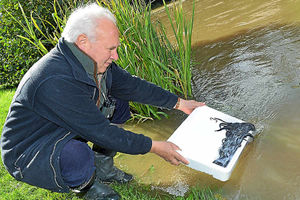Slippery shipment of eels released in Shropshire's River Teme
[gallery] More than 25,000 young visitors arrived in Shropshire in the back of a van – and then promptly swam away.

The huge consignment of European eels was delivered to the River Teme as part of an attempt to re-stock its wildlife.
The year-old fish, known in the UK as "glass eels" because of the their see-through skin when young, arrived at the Linney Riverside Park below Ludlow Castle in polystyrene boxes yesterday.
The slippery shipment was brought to the county by the Sustainable Eel Group, a Europe-wide organisation devoted to helping eel populations recover.
And, although they came up from Gloucester, the little eels had already travelled much further under their own steam.
European eels have a mysterious life cycle but are thought to spawn in the Sargasso Sea in the middle of the North Atlantic Ocean.
Since the 1970s populations in Europe have declined by a 90 per cent and the EU now has a regulation urging all member countries to help the species survive.
Andrew Kerr, Sustainable Eel Group chairman, was overseeing the release.
He said: "The eel is on a list of critically endangered species which is down to the decline in the arrival of babies from the Sargasso Sea. They take about two years to float over the ocean.
"We have very little information about what happens in the oceans – we don't even know what they eat there – but scientists think what happens there is the biggest factor in their decline. It could be the change in currents or a lack of food for them."
But those that get here face yet more problems, he said.
"Migration pathways are blocked off, natural ways into bogs, ditches, rivers and brooks by concrete walls and steel doors.
"The lasting solution is to let the fish come and go freely – the temporary solution is re-stocking like we are doing today.
"There are some places that have nothing but that species, but there are others places that hardly get any eels at all. So the idea is to move eels from where they're super-abundant to where they're in decline."
He said about 100 million eels came up the Severn estuary this year.
About 20 million were caught using hand-net fishing between Gloucester and Tewkesbury in the spring. They were then held and grown for three months by UK Glass Eels.
The company sells eels all over Europe, particularly to Holland, Sweden and Germany.
"The Teme was chosen by us and a team of scientists," Mr Kerr said, "It's a wonderful, natural river full of goodness and insect life."
Mike Morris, senior project manager with the Severn Rivers Trust said the Teme was identified as a good area for repopulation after a nationwide search.
"The Teme is the second largest sub-catchment of the Severn, it's fantastic for salmon, trout and general wildlife.
"It's a Site of Special Scientific Interest and a special area of conservation."
He said the trust was taking the lead in the River Teme Partnership, made up of organisations and community groups looking to improve the river and its wildlife.
Other work taking place includes a fish-pass on the nearby Dinham Weir, which is just days away from completion.
A fish pass allows migrating fish such as salmon and eel to more easily climb the weir, with steps and bristles built in.
Five eel drops were made up and down the Teme yesterday.
Simon Soffe of the Sustainable Eel Group said they had already released eels in Blagdon Lake, Somerset and on the Fens in Lincolnshire.
Eel factbox:
The European eels life cycle has been a mystery for centuries. Ancient Greek philosopher Aristotle thought that eels did not reproduce, but spontaneously generated from mud after it rained, growing from the guts of wet soil.
Today it is thought they spawn in the ocean, their larvae drifting across to land. When approaching the coast the larvae transform into tiny glass eels and enter river estuaries where they swim upstream and transform into small adult eels.
They spend most of their five to 20-year lives in fresh water, their sides and belly changing from grey to yellow to silver and later return to the ocean to spawn and then die.
In the early 1900s, Danish researcher Johannes Schmidt identified the Sargasso Sea, in the North Atlantic Ocean, bordered by the Gulf Stream and the North Atlantic Current, as the most likely spawning grounds for European eels.
Attempts to rear eels in captivity in Holland have failed.





